- The journal
- nike junior av hooded top black white , Nike Air Yeezy Slippers
- 100 - Travis Scott x Jordan Jumpman Jack Trainer Sail DR9317 , Jordan 11 Win Like 96 Gym Red Sneaker tees Black Sneakerhead Grinch - IetpShops
- 104 - Air Jordan 4 Laser Black kaufen kannst - Jordan Legacy 312 Storm Blue - AQ4160
- stan smith nuud women black and blue jordan shoes - IetpShops - Adidas AdiFC Orlando Pirates
- Nike Jordan Jumpman hoodie in grey - release dates & sneakers., Jordans - Yeezys, Urlfreeze News
- a ma maniere air jordan 1 high do7097 100 release date
- air force 1 shadow
- air jordan 1 high og university blue 555088 134
- air jordan 1 retro high og university blue 555088 134
- kids air jordan
- Aims & Scope
- Editorial Policies and Processes
- Scientific and Methodological Rigor
- Production and Administration
- Committees
- Authors
- Ethical Considerations
- Submit Article
- Archive
- Indexation
- Search
- Contact us
Farm Comunitarios. 2023 Apr 14;15(2):12-19. doi: 10.33620/FC.2173-9218.(2023).11
Pilot trial on the detection of patients with undiagnosed diabetes mellitus type 2 performed in community pharmacies in Valladolid. Environmental impact evaluation
INTRODUCTION
In the Di@betes study performed in Spain to ascertain diabetes prevalence, it was estimated that approximately 30% of the population had some type of abnormality in carbohydrate metabolism. According to data from this study, the global prevalence of diabetes mellitus adjusted for age and sex was 13.8%; approximately half (6%) was undiagnosed diabetes mellitus (1).
The symptoms of this disease, in general, have a low intensity or may even not manifest themselves, whereby high blood glucose levels can lead to various complications (2). Not knowing the diagnosis of this disease often involves a long time during which (3,4) these patients could present a high risk of developing macrovascular and microvascular complications (5,6). For this reason, early detection and commencing treatment as soon as possible to reduce the course and complications of this disease are so important (7,8).
Screening tests to determine diabetes are recommended by institutions such as the NICE (9), Canadian Task Force (10), ADA (6) and SED (11).
The risk of suffering diabetes can be determined by the Frindrisc questionnaire, one of the most commonly used tools because it is a non-invasive technique that enables identifying patients at higher risk of developing diabetes mellitus type 2 (DM2) and if necessary, performing complementary tests to determine the diagnosis of undiagnosed DM2; or, on the other hand, following them up periodically to try and delay disease onset (11-13). In Spain, the capacity of this test was validated by means of the Pizarra study in 2012 (14).
At the moment knowing the environmental impact of the activities performed is very convenient, since the health sector accounts for 4.4% of global CO2 emissions, putting it in fifth place in terms of contribution of emissions to the atmosphere (15-17). This is especially important in rural areas, where doctors, appointments or medical consultations are not so available, and patients sometimes need to move to other towns to undertake certain medical tests or pick up the results.
The measurement of clinical parameters, as well as disease prevention by performing screening and detection of hidden diseases or disease risk, are some of the services provided by the pharmacist in relation to health (18). Performing this type of test in the community pharmacy helps to rationalize health spending and improve the quality of life of patients (15-17,19), particularly in rural areas, where avoiding travel for a capillary blood glucose determination benefits the patient and the environment; CO2 emissions are reduced.
The aim of this study is to evaluate the results of a DM2 detection programme from community pharmacy using the Findrisc test and in applicable cases determination of capillary blood glucose; and refer them, if applicable to their health centre for a possible diagnosis. As a secondary objective, analyzing the environmental impact of the action performed is proposed.
MATERIAL AND METHODS
Epidemiological, observational, cross-sectional study performed in the pharmacies of Valladolid from 10 to 30 November 2021.
Taking part in the study was offered in general and voluntarily to all pharmacies in Valladolid. Those pharmacies that agreed to participate (15.7%) received specific online training on the procedure to perform. The Findrisc test was made available to fill in with each participant and data was subsequently transferred to an online questionnaire created for having all the data collected.
The Findrisc test was performed on people who met the inclusion criteria: person who visits the pharmacy, aged over 18, not previously diagnosed with diabetes and who agreed to voluntarily take part in the study. If the total score obtained was <15 points, pharmaceutical advice was offered on healthy lifestyle, diet and exercises. In cases with results >15 points, the participant was offered the possibility of returning the following day in a fasting state to undertake a basal capillary blood glucose after signing the corresponding informed consent. This test was performed by capillary puncture and measured with validated and self-calibrating glucometer Glucomen® Aereo 2K from A. MENARINI diagnostics. If basal capillary blood glucose was ≥110 mg/dL (20,21) the participant was referred to the physician to confirm the possible diagnosis of DM2 by HbAc1 analysis. Those patients who were referred to the physician were given a derivation sheet and asked to return to the pharmacy to be informed about the results obtained.
The result obtained in the Findrisc test was considered as the primary endpoint. Subgroups were set out according to result.
• Low risk: <7 points.
• Slightly high risk: 7-11 points.
• Moderate risk: 12-14 points.
• High risk: 15-20 points.
• Very high risk: >20 points.
Finally, it was analyzed whether or not there was confirmation of DM2 diagnosis in patients referred to the physician.
Height and weight were measured with approved scale with built-in height rod and waist circumference using a flexible tape measure. The measurement was taken at navel height.
Figure 1 shows the study’s general outline.
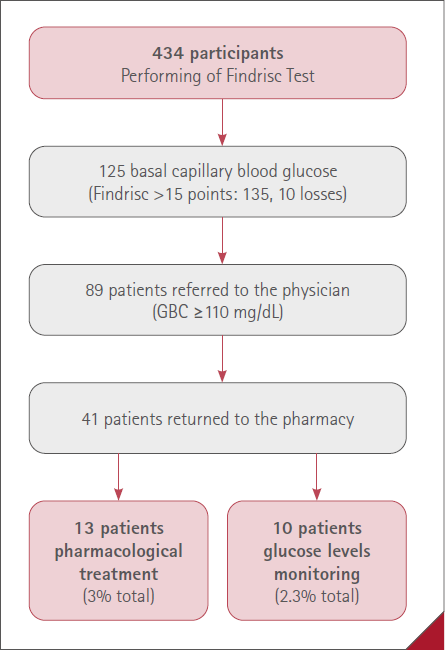
Figure 1 General scheme of the study
Environmental impact measurement
The distance from each pharmacy to its reference health centre where patients would be referred if necessary was determined by Google Maps.
The terra.org calculator was used to determine the carbon footprint saved by pharmacies using this intervention. For city movements, calculations were made by selecting bus as a means of transport (intermediate between the routes travelled on foot or by private car). The calculator used indicated that 1 km covered by a bus generates 0.0620091 kg of CO2. However, in the rural area the traditional car was selected as means of transport due to less availability of public transport. For these calculations, over a 1 km journey, a consumption of 0.1899847 kg of CO2 was estimated.
The number of transfers avoided was calculated as follows:
- For participants who did not need to be referred to the health centre, two transfers were avoided.
- For participants who were referred to the health centre, twice as many trips were avoided, that is, four transfers.
Once all the km saved with the pharmacy interventions were added, that figure was multiplied by CO2 consumption over 1km travelled (CO2 factor) and by two in total cases not referred or by four in those cases referred to the physician. Finally, all the results were added to ascertain the total CO2 saving and divided between the 20 days the intervention lasted to find out the daily average.
Statistical analysis
The mean and standard deviation of the total score of the Findrisc test and measurements of basal capillary glycemia were calculated.
RESULTS
A total of 44 pharmacies in the province of Valladolid took part in the study, 16 of which were in the rural area and the remaining 28 urban. They represented 15.7% of pharmacies in the province. The collaborating pharmacists totalled 58, considering that in some pharmacies, more than one pharmacist participated in the study.
A total of 434 cases were collected. The characteristics of the population studied are listed in Table 1, which includes the responses after performing the Findrisc test.
Table 1 Characteristics of the population taking part in the study
(Results ofthe answers to the Frindrisc questionnaire of the 434
study participants.)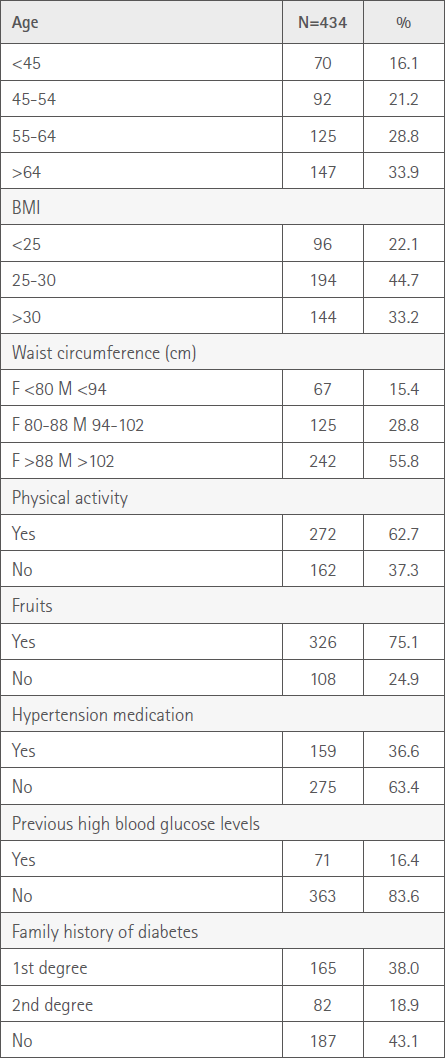
More than 80% of study participants are older than 45 years old and approximately 60% were women. Regarding the considered risk factors for this disease, more than 75% of participants presented BMI greater than 25, while approximately 85% have waist circumference above normal.
Table 2 Score obtained in the Frindrisc test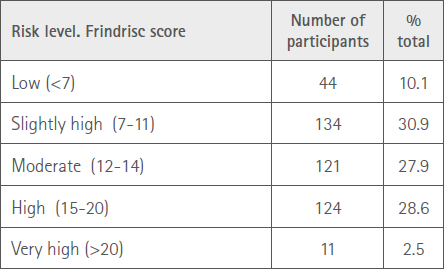
Of the 434 tests performed, with a mean of 12.5 (SD=4.5), in 135 results were obtained with high or very high risk (Table 2). Of the candidate participants for basal capillary blood glucose, four of them did not sign the informed consent and another six, for unknown reasons were not tested either (Table 3).
Table 3 Capillary blood glucose results (Capillary blood glucose results performed on the study partici- pants who obtained a Frindrisc test score equal or higher than 15 points)
Capillary blood glucose results
For participants with a Findrisc test result above 15 points, basal capillary blood glucose was determined for 125 participants (10 losses) with a mean result of 124.5 mg/dL (SD=33.6). Of the blood glucose tests performed 71.2% led to results higher than 110 mg/dL and were referred to their primary care doctor for other tests, and as appropriate, confirm the diagnosis.
Referral results
Of the total patients referred to the physician (n=89), 41 returned to the pharmacy to be notified about the results (42.3%); for 13 of them (14.6% of the participants referred) the diabetes diagnosis was confirmed, and pharmacological treatment was established (Table 4). If we consider the total number of participants (n=434), the new patients diagnosed with diabetes represents 3% of the analysed sample.
Table 4 Physician referral results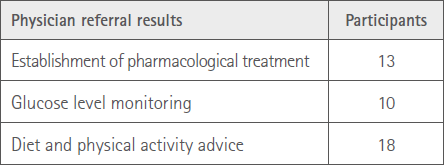
Environmental impact
The CO2 emissions saved during the 20 days that the campaign lasted are listed in Table 5.
Table 5 Carbon footprint in rural and urban areas
(Quantification ofCO2savings due to the actions performed in the pharmacies, considering the travel avoided by patients to their reference
health centre
DISCUSSION
With this study, in addition to being able to detect a considerable number of patients with high or very high risk of suffering from DM2, we can determine that the pharmacy is a good undiagnosed DM2 screening point, which informs the susceptible population about the complications that might arise if the early stage of the disease is not controlled. Moreover, patients are taught guidelines and advice in terms of both nutritional and physical activity to delay its onset (Annex). The number of patients analysed (434 in 20 calendar days, 14 working days) shows the interest of users in performing this type of activity in community pharmacies.
The characteristics of the sample are similar to those found in two previous studies (21,22). In our case 80% of participants were over 45 years old, compared to 75% of the other studies (21,22). Approximately 60% of our participants were women, which coincides with the data obtained in the two studies mentioned, 60%-65% of their sample. In regard to risk factors for the onset of diabetes, more than 75% of our sample presents BMI over 25; the same percentage was obtained in reference studies. Regarding waist circumference, 85% of our participants have values over normal and somewhat higher than those of the other two studies: 75% in both.
The figures for high or very high risk of developing diabetes obtained in this study were 23%, similar to those of previous studies (21, 22). This risk level is reflected above all in participants as of the age of 55 or in those with BMI above 25 kg/m2, which reveals that DM2 is a pathology associated with age and affected by risk factors such as overweight or obesity.
The new diagnoses obtained with our study were 3%. This value is similar to another previous study (23), even though the latter has a larger sample.
Focusing on the environmental impact, the data obtained during the 20 days in which the study was performed, extrapolating to a whole year, the atmospheric emissions saved stands at 19,509.23 kg of CO2. To get a more graphic idea, the saving during those 20 days would be equivalent to:
- The emission produced by a person who travels a 8 km return trip to work by car daily for an entire year.
- The emission produced by 8 people who travel a 3 km return trip from the centre of Valladolid to their homes for a whole year by bus.
- The emission produced by a person who performs a Valladolid-Madrid return trip by train for 6 months daily including Saturdays and Sundays.
An important limitation that we have, has been the return of information received from patients referred to the physician. At this point we included both patients who returned after commencing pharmacological treatment or diet and physical activity patterns, as well as those called by the physician for subsequent analysis and monitoring of blood glucose levels. Of the total patients referred in urban areas the information that came back after the recommendation to request an appointment with their physician did not attain 30%. However, in rural areas these figures are very different, since 85.2% of patients went to the pharmacy to report the results of the consultation. These figures show the degree of trust in rural pharmacists and the greater connection between health professionals, aspects far removed in the city where patients can be passing through or not have a fixed pharmacy to visit.
ACKNOWLEDGEMENTS
To all pharmacists taking part in the data collection for the study.
Jacobo Cristellys Sancho, Loredana Settimo Falsitta, Marta Mª Cortés Llanes, Marta Lázaro Sancho, Victorina García del Pozo, Ana Teresa Jódar Pereña, José Manuel Santana de Miguel, María Martín González, María Carmen Casado Castañeda, Pablo Coupeau Borrás, Mar Esteban Rodríguez, Ángel Díez Rivera, Soraya Molina Alonso, Arturo Coloma Sánchez, Marta Fernández Bayón, Rosa Nieto Martín, Noelia Martín Montaña, Ana Isabel Vicente García, Virginia Hernández Calle, Elena Fernández Cancillo, María del Villar Igea, Azucena Treviño García, Antonio Cruz de la Cuesta, Inés Rico Calle, Fernando Salvador Sánchez, Jorge Martínez Olmedo, Ignacio de la Cuesta Sánchez, Minerva Tejero Verdugo, Andrés Sanz Estalayo, Lidia Bermúdez González, Sofía del Pozo Martínez, Jorge Sánchez González, Carmen Casado López, Esther Cid Concha, María del Mar García Colino, Mercedes Galisteo Reina, Basilia Illana Fernández, Vanesa López Pérez, Beatriz Santamaría Alonso, Mercedes Martín Andrés, Pilar Rodrigo Rodríguez, Alejandro García Nogueiras, Mª Encarnación Martín Moreno, Marta Isabel Perucho Antona, Amparo Moreno García, María del Carmen Sanz Valentín, Blanca María Rodrigo Rodríguez, María Monge Postigo, Cristina Posada Gómez, Rafael Martínez Olmedo, Alicia Mellado Álvarez, Isabel Maeso Miguel, Lola Parra Astorgano, M Rosario Morillo Ruiz, Mª Lourdes Martín Lara, María Ángeles Fernández Alonso, María del Carmen Sánchez Curto, Luis Rodríguez Carrascal.
REFERENCES
1. Soriguer F, Goday A, Bosch-Comas A, Bordiú E, Calle-Pascual A, Carmena R, et al. Prevalence of diabetes mellitus and impaired glucose regulation in Spain: the Di@bet.es Study. Diabetología. 2012 Jan;55(1):88-93. doi:10.1007/s00125-011-2336-9.
2. Gómez Ramon O, Sanz Vela N, Alvarez Hermida A, García Soidán A (Coord.). Abordaje integral del paciente con DM2 en enfermería y medicina. Fundación redGDPS 2021. ISBN: 978-84-09-32813-0. Available at: https://www.redgdps.org/gestor/upload/colecciones/Guia%20de%20enfermeria_2%C2%AAed_web.pdf
3. Simmons RK, Echouffo-Tcheugui JB, Sharp SJ, Sargeant LA, Williams KM, Prevost AT, et al. Screening for type 2 diabetes and population mortality over 10 years (ADDITION-Cambridge): a cluster-randomised controlled trial. Lancet. 2012;380(9855):1741-8. doi:10.1016/S0140-6736(12)61422-6.
4. Simmons RK, Rahman M, Jakes RW, Yuyun MF, Niggebrugge AR, Hennings SH, et al. Effect of population screening for type 2 diabetes on mortality: long-term follow-up of the Ely cohort. Diabetologia. 2011;54(2):312-9. doi:10.1007/s00125-010-1949-8.
5. Barutell Rubio L (Coord.). La enfermera de Primaria y la Diabetes. Guía de la RedGDPS. Badalona: Euromedice ediciones médicas; 2011. Available at: http://www.redgdps.org/gestor/upload/file/guia%20enfermeria%20redgdps%20diabetes%20tipo%202.pdf
6. American Diabetes Association. Diagnosis and classification of diabetes mellitus. Diabetes Care. 2014;37(Suppl 1):S81-90. doi:10.2337/dc14-S081.
7. Lindenmeyer A, Hearnshaw H, Vermeire E, Van Royen P, Wens J, Biot Y. Interventions to improve adherence to medication in people with type 2 diabetes mellitus: a review of the literature on the role of pharmacists. J Clin Pharm Ther. 2006;31(5):409-19. doi:10.1111/j.1365-2710.2006.00759.x.
8. Uusitupa M, Khan TA, Viguiliouk E, Kahleova H, Rivellese AA, Hermansen K, et al. Prevention of Type 2 Diabetes by Lifestyle Changes: A Systematic Review and Meta-Analysis. Nutrients. 2019;11(11):2611. doi: 10.3390/nu11112611.
9. National Institute for Health and Care Excellence. Type 2 diabetes: prevention in people at high risk. [Internet] (Great Britain). (2017) National Institute for Health and Care Excellence (NICE). Available at: https://www.nice.org.uk/guidance/ph38/resources/type-2-diabetes-prevention-in-people-at-high-risk-pdf-1996304192197
10. Pottie K, Jaramillo A, Lewin G, Dickinson J, Bell N, Brauer P, et al. Canadian Task Force on Preventive Health Care. Recommendations on screening for type 2 diabetes in adults. CMAJ. 2012 Oct 16;184(15):1687-96. doi:10.1503/cmaj.120732. Erratum in: CMAJ. 2012 ;184(16):1815.
11. Mata-Cases M, Artola S, Escalada J, Ezkurra-Loyola P, Ferrer-García JC, Fornos JA, et al.; Grupo de Trabajo de Consensos y Guías Clínicas de la Sociedad Española de Diabetes. Consenso sobre la detección y el manejo de la prediabetes. Grupo de Trabajo de Consensos y Guías Clínicas de la Sociedad Española de Diabetes. Endocrinol Nutr. 2015;62(3):e23-36. doi:10.1016/j.endonu.2014. 10.008.
12. Lindström J, Tuomilehto J. The diabetes risk score: a practical tool to predict type 2 diabetes risk. Diabetes Care. 2003 Mar;26(3):725-31. doi:10.2337/diacare.26.3.725.
13. Saaristo T, Peltonen M, Keinänen-Kiukaanniemi S, Vanhala M, Saltevo J, Niskanen L, et al; FIN-D2D Study Group. National type 2 diabetes prevention programme in Finland: FIN-D2D. Int J Circumpolar Health. 2007;66(2):101-12. doi:10.3402/ijch.v66i2.18239.
14. Soriguer F, Valdés S, Tapia MJ, Esteva I, Ruiz de Adana MS, Almaraz MC, et al. Validación del FINDRISC (FINnish Diabetes Risk SCore) para la predicción del riesgo de diabetes tipo 2 en una población del sur de España. Estudio Pizarra. Med Clin (Barc). 2012 Apr 14;138(9):371-6. doi:10.1016/j.medcli.2011.05.025.
15. Filfilan A, Anract J, Chartier-Kastler E, Parra J, Vaessen C, de La Taille A, et al. Positive environmental impact of remote teleconsultation in urology during the COVID-19 pandemic in a highly populated area. Prog Urol. 2021;31(16):1133-38. doi:10.1016/j.purol.2021.08.036.
16. Karliner J, Slotterback S, Boyd R, Ashby B, Steele K. Huella climática del sector de la salud. Cómo contribuye el sector de la salud a la crisis climática global: oportunidades para la acción. Salud sin Daño. 2019. Cuidado de la salud climáticamente inteligente Libro Verde Número Uno. [cited Mar 2022]. Available at: https://saludsindanio.org/sites/default/files/documents-files/5953/1%29%20Huella%20clim%C3%A1tica%20del%20sector%20salud%20-%20Reporte%20en%20espa%C3%B1ol_0.pdf
17. Purohit A, Smith J, Hibble A. Does telemedicine reduce the carbon footprint of healthcare? A systematic review. Future Healthc J. 2021;8(1):e85-e91. doi:10.7861/fhj.2020-0080
18. Foro de Atención Farmacéutica-Farmacia Comunitaria (Foro AF-FC). Guía práctica para los Servicios Profesionales Farmacéuticos Asistenciales en la Farmacia Comunitaria. Madrid: Consejo General de Colegios Oficiales de Farmacéuticos; 2019. Available at: https://www.farmaceuticos.com/wp-content/uploads/2021/02/2021-guia-practica-spfa.pdf
19. Forner D, Purcell C, Taylor V, Noel CW, Pan L, Rigby MH, et al. Carbon footprint reduction associated with a surgical outreach clinic. J Otolaryngol Head Neck Surg. 2021 April 19;50(1):26. doi:10.1186/s40463-021-00510-4.
20. Miranda Fernández-Santos C (Coord.). Documento SEMG ‘Manejo y Derivación de la Diabetes mellitus tipo 2 (DM2) en Atención Primaria’. Madrid: Grupo SANED; 2018. Available at: https://www.semg.es/images/documentos/grupos/SEMG_manejo_derivacion_DM2.pdf
21. Arias JL, Linares FM, Santamaría JM. Detección de posibles diabéticos no diagnosticados en una farmacia comunitaria. Ars Pharmaceutica, 2007;48(2):187-200. Available at: https://revistaseug.ugr.es/index.php/ars/article/view/4985
22. Fornos-Pérez JA, Andrés-Rodríguez NF, Lorenzo-Veiga B, Huarte-Royo J, Vivar-Fernández M, Andrés-Iglesias JC, García-Rodríguez P. Detección de personas en riesgo de padecer diabetes en farmacias comunitarias españolas. Farm Comunitarios. 2015 Jun 30;7(2):14-24. doi:10.5672/FC.2173-9218.(2015/Vol7).002.03.
23. Fornos-Pérez JA, Andrés-Rodríguez NF, Andrés-Iglesias JC, Luna-Cano R, García-Soidán J, Lorenzo-Veiga B, et al. Detection of people at risk of diabetes in community pharmacies of Pontevedra (Spain) (DEDIPO). Endocrinol Nutr. 2016;63(8):387-96. doi:10.1016/j.endonu.2016.06.002.
Annex. Infographic provided to patients about DM2, its complications, habits and nutritional and physical activity advice to try to delay its onset
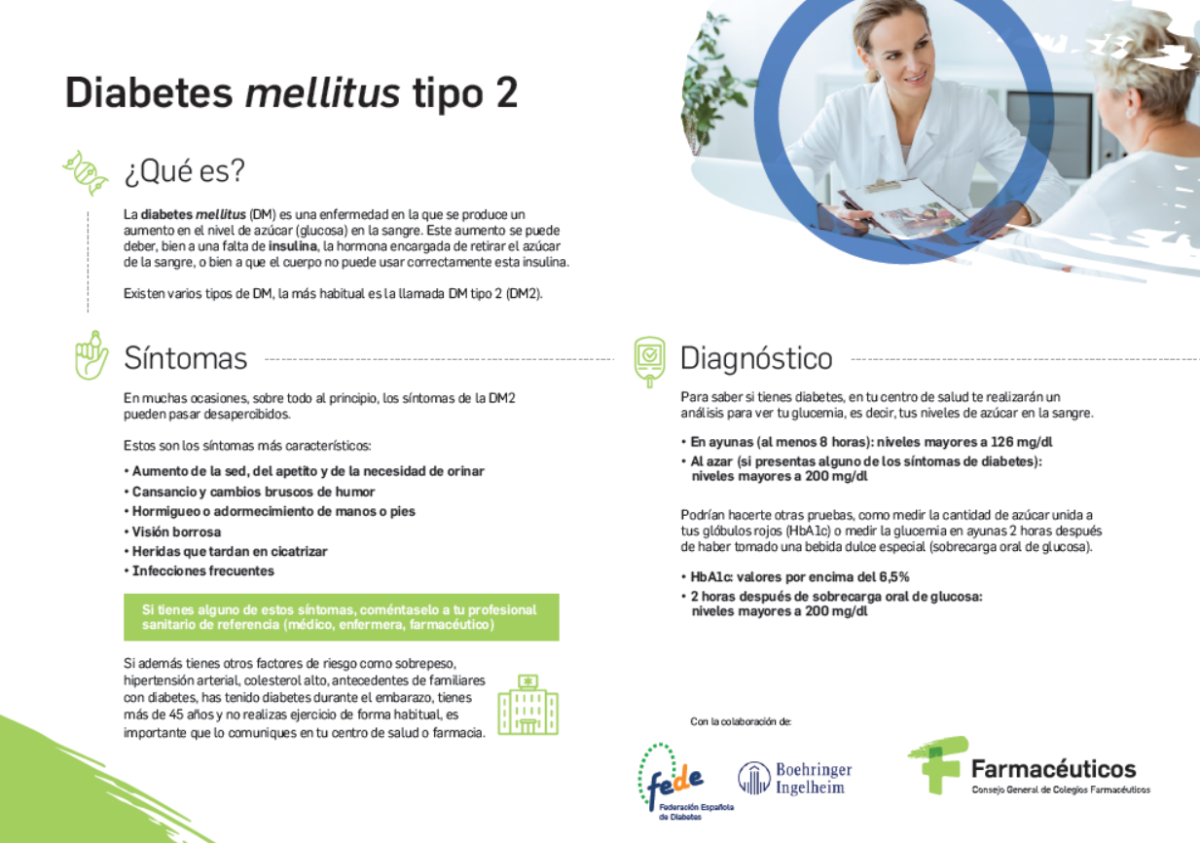
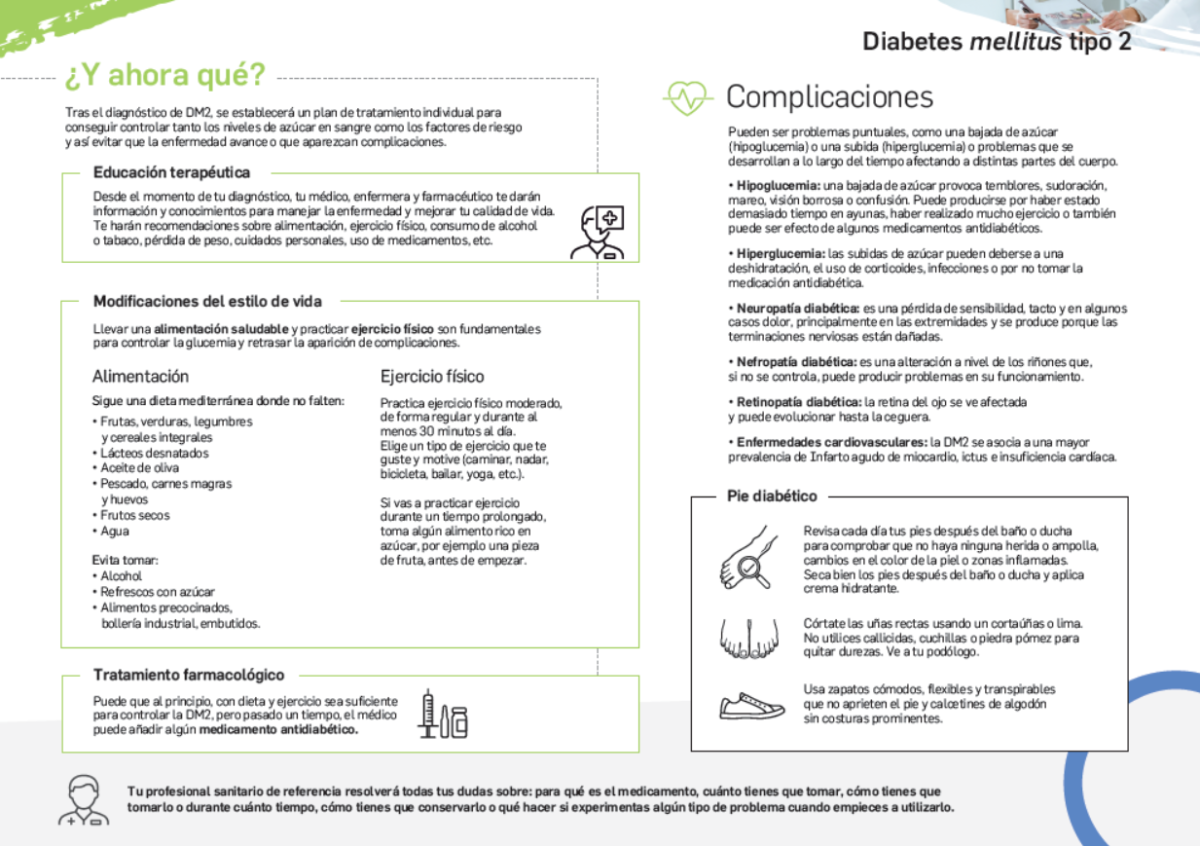
Editor: © SEFAC. Sociedad Española de Farmacia Clínica, Familiar y Comunitaria.
Copyright© SEFAC. Sociedad Española de Farmacia Clínica, Familiar y Comunitaria. This article is available from url https://www.farmaceuticoscomunitarios.org/. This work is licensed under a Creative Commons Attribution-NonCommercial-NoDerivatives 4.0 International License. The images or other third party material in this article are included in the article’s Creative Commons license, unless indicated otherwise in the credit line; if the material is not included under the Creative Commons license, users will need to obtain permission from the license holder to reproduce the material. To view a copy of this license, visit https://creativecommons.org/licenses/by-nc-nd/4.0/deed.en


